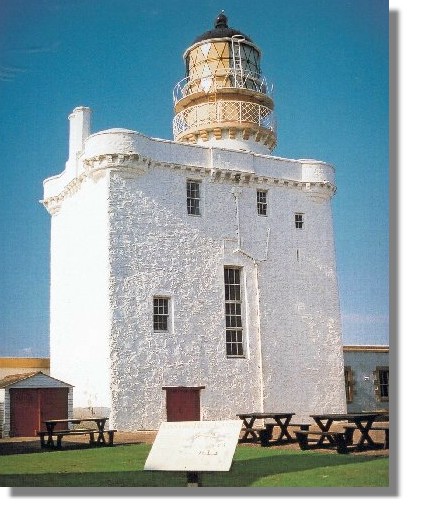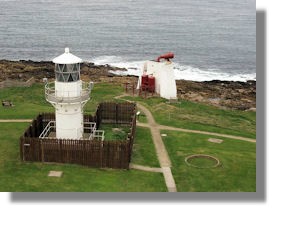

Lighthouse Beacons from Scotland
Kinnaird Head Castle Lighthouse

Kinnaird Head (from the Gaelic "An Ceann Ārd", meaning "high headland") projects into the North Sea, within the town of Fraserburgh, Aberdeenshire on the east coast of Scotland. The 16th-century Kinnaird Castle was converted in 1787 for use as the Kinnaird Head Lighthouse, the first lighthouse in Scotland to be lit by the Commissioners of Northern Lights who built many more on Scotland's coastline over the next 200 years or so. It was installed by a Mr Thomas Smith from Edinburgh, who was the father-in-law of Robert Stevenson who succeeded him as Engineer to the Northern Lighthouse Board (Robert Stevenson was grandfather of the author Robert Louis Stevenson). A lantern was set on a corner of a tower of the old castle in Fraserburgh owned by Lord Saltoun. The lights in those days were fixed, using arrays of lamps burning whale oil, each of them backed by its own parabolic reflector made up of a multitude of facets of silvered mirror-glass set on a plaster mould. Kinnaird Head was the most powerful light of its time, and contained 17 reflectors arranged in 3 horizontal tiers. In clear weather, the light could be seen 12 to 14 miles away. (The graphic of Kinnaird House Lighthouse on the right is via Wikimedia)
The structure was rebuilt in 1824 when internal alternations were made to the tower to accommodate a new lantern and additional buildings were constructed for the Lightkeepers. The graphic of the internal stairs on the left is via Wikimedia.
The promontory on which the Castle of Kinnaird was built is held to be the Promontorium Taixalium referred to by Ptolemy, an ancient Egyptian who lived in Alexandria in 140 AD. So Kinnaird Head was known geographically nearly 1,500 years before the present town of Fraserburgh was founded by Sir Alexander Fraser towards the close of the 16th Century. The picture on the right is via Wikimedia and is of the actual light, inside the old lighthouse.
During World War II, Fraserburgh was known as "Little London" because of the heavy bombing and machine-gun attacks on the town due to the ammunitions manufacture and work carried out on Rolls Royce aircraft engines and parts for Bofors guns. Despite that, the lighthouse was only slightly damaged by a "near miss"
The present lighthouse is a new building created in 1991 at which stage it was automated and the original building now houses the Museum of Scottish Lighthouses. This incorporates the original lighthouse and a modern building housing collections of lenses and other artefacts from many lighthouses across Scotland. It is now listed as a building of Architectural/Historical interest by Historic Scotland. The foghorn beside the new lighthouse is no longer operational. The graphic here of this new building is by David Hawgood via Wikimedia.
Return to Index of Lighthouse Beacons from Scotland




